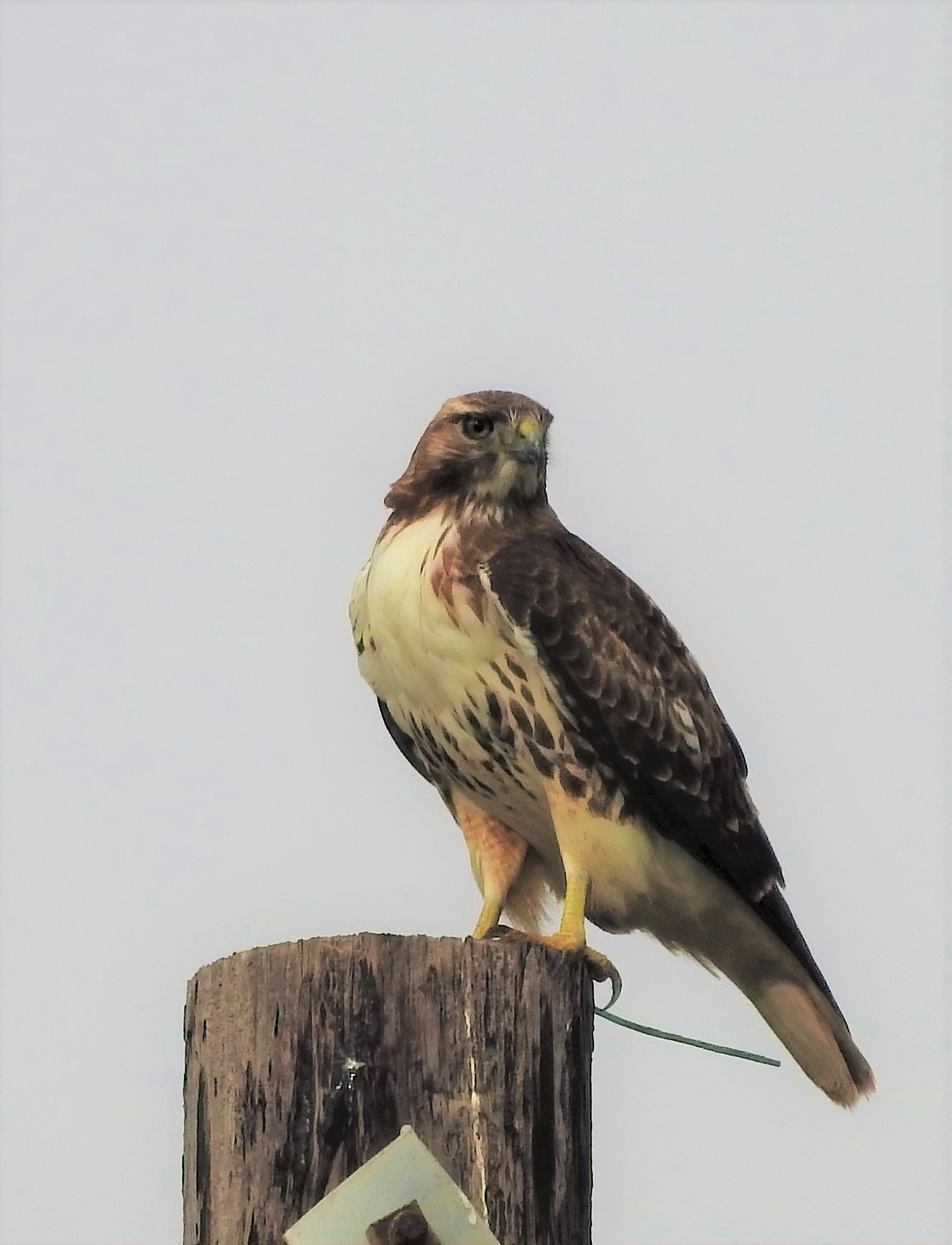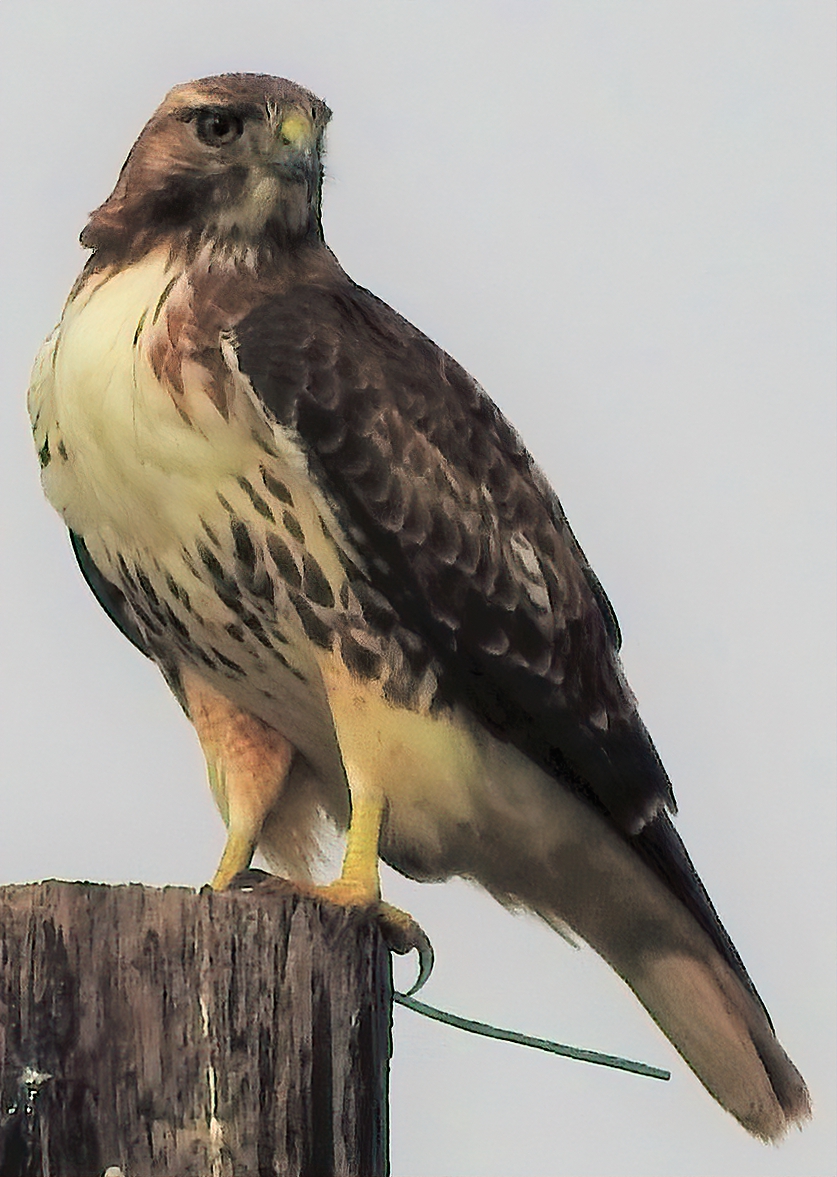A vanilla chest rippled with chocolate and an intense glare alerted me to this red-tailed hawk scrutinizing mesquite and yucca-dotted grasslands—and, incidentally, bicyclists and joggers— from a 60-foot pole along Brownsville’s bike trail this November. Now I see it here often, as I did last winter. Could this be the selfsame hawk?

Quite possibly, I’m told. Interestingly, I haven’t seen another in its company. Is it vacationing alone? I am honored that it deems our wintry fields—well-stocked with squirrels, rabbits, snakes, birds and carrion— to its liking.
The red-tail, the U.S.’s most abundant hawk, likely owes its success to its broad selection of both prey and habitats, coupled with a relative tolerance for humans. From highways, we commonly spot these hawks scanning median strips and edges for creatures. If not in person, we’ve likely heard the red-tail’s piercing scream of Kee-eeee-arr! in movies, as it is often dubbed in for the weaker cry of the bald eagle.
The red-tailed hawk (Buteo jamaicenis) is a buteo—an especially robust, broad-winged, wide-tailed raptor. With 14 recognized subspecies, the plumage of these large hawks varies considerably, from the pale Great Plains’ Krider’s hawk to the usually dark Harlan’s hawk of the West. Occurring in light, intermediate and dark morphs, or colors, lighter birds have notably mottled chests. Most, but not all, sport the namesake tail, varying from cinnamon to rose-colored. Some ornithologists suggest that darker birds hunt best in low light, like that of forests, while lighter birds are more successful in bright, open areas.
Though red-tailed hawks breed throughout most of North America, they rarely if ever do so in the Rio Grande Valley. Partial migrants, hawks leave breeding grounds that cannot provide ample wintertime prey. Singly or with a few others, they migrate by flapping, gliding and riding thermals and updrafts while avoiding large bodies of water. The Valley’s migrants, mostly lighter morphs, but some dark ones, hail from throughout North America.
This adaptable hawk requires a lofty perch from which to eyeball prey, which it finds in diverse habitats—plains, woodlands, pastures, rain forests, thornscrub and deserts.
Usually monogamous, red-tails engage in a courtship dance, circling, soaring, diving and sometimes interlocking talons while spiraling downwards. The pair builds a sizeable stick nest high in trees, cliffs, saguaro cacti or man-made structures. Both, but mainly the female, incubate eggs.
Some even nest in bustling cities. In 1991, a hawk dubbed Pale Male, unable to outcompete crows for nesting space in Central Park, set up housekeeping outside a luxurious apartment at 927 Fifth Avenue in New York City. He, along with a succession of mates and chicks, developed quite a fanbase, inspiring a documentary, song and several children’s books. The oldest known wild red-tail lived to be close to 31, at least, but whether Pale Male, at 30, survives is hotly debated. In 2007, an Audubon-commissioned study found 32 nesting pairs in New York City.

Though largely perch hunters, red-tails also hunt on the fly, stooping—diving at great speeds—hovering and kiting, or using air currents to maintain position. As it lands, the hawk thrusts its legs forward. Approaching a rattlesnake on foot, it may spread its wings to form a hood so a striking snake will hit a mere wall of feathers. Then it swiftly dispatches the serpent by biting its neck and head. From midair, a red-tail may snag a lagging bat during a massive sunset cave exodus. The hawk usually carries mammals to a perch to swallow whole. It first plucks and beheads birds. It may eat what it can of large prey on the ground, revisiting a corpse later. Some prey puts up a fight, biting the hawk’s toes and legs.
Red-tailed hawks appear to be thriving. Formerly hostile farmers now value them as rodent-killers. Falconers prize them, also.
While I bemoan impending construction which may deter wintering northern harriers, it’s possible that—given its general tolerance for human activity—this may not dissuade the visiting red-tailed hawk who makes its winter home among towering utility poles. I do hope it returns.